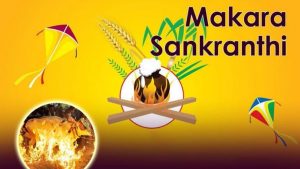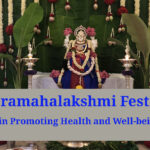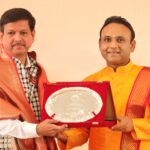Makara Sankranthi is the Suggi or harvest festival for farmers. Makara Sankranthi festival is believed to be a time for peace and prosperity. It is the first festival of the year and signifies the arrival of the spring and the beginning of the harvest season.


Indians are inheritors of a culture which integrated spirituality and science with great ceremony in the form of festivals. To bring the science and spirituality to life, the philosophical ideas (Vedas) were transformed into beautiful allegorical stories (Puranas). From these Puranas, festivals and traditions are developed to bring family and community together. Underlying it all is the human instinct of joy and happiness and remembrance of the principle of the victory of good over evil in the constant struggle between them.
Makara Sankranthi in reference to God Surya (Sun):
Makara Sankranthi, also known as Makara Sankramana, Suggi Habba, Magha Mela, Maghi, Bhogi, Pongal, is a festival day in the Hindu calendar, in reference to God Surya (Sun). It is observed each year in January month. It marks the first day of sun’s transit into the Makara (Capricorn), marking the end of the month with the winter solstice (winter season) and the start of longer day’s summer solstice (summer season). The festival Makara Sankranthi is a solar event making it one of the few Hindu festivals which fall on the same date in local calendars every year: 14 January, with some exceptions, when the festival is celebrated on 15 January.
Makara means crocodile, Sankranthi means to cross into or change. The Makara or crocodile represents the materialistic World and Sankranthi gives an opportunity to get away from the clutches of the crocodile or the materialistic World. Makara Sankranthi marks the transition of the Sun from Sagittarius (Dhanu Rashi) to the zodiac sign of the Capricorn (Makara Rashi).
In other countries too, the day is celebrated by Hindus, but under different names and in different ways like in Nepal – Khichdi Sankranthi, Bangladesh – Poush Sankranthi, and Pakistan – Tirmoori.


Much before contemporary scientists came up with their observations of solar system a few hundred years ago, scholars of ancient India (5000 years ago) already knew that sun is the center of our celestial system and is the source of energy for all planets including our planet earth, which takes 365 days to revolve around the Sun. This complete cycle of 360 degree which is also called the solar calendar (1 year) is divided into 12 months (January to December) or zodiacs (12 Rashis – Sagittarius Dhanu Rashi to Capricorn Makara Rashi) of 30 degree each (360/12=30) and each zodiac is associated with certain characteristic depending on the positions of earth & sun in relative to each other, which in turn also determines the season & radiation patterns.
The zodiac months of the Sun from July to December witness decreasing sunlight, and after that, the subsequent zodiac months witness increase in sunlight. For an “observer”, it looks like the Sun is on a downward journey between July to December and this downward journey suddenly changes to upward journey or northward movement in late December and early January. Since uttara means northward and aayana means movement in Sanskrit, this phenomenon of phase reversal from southward movement to northward movement of the Sun is called “Uttara Ayana” or “Uttarayan” in short. The Surya Siddhanta defines Uttarāyaṇa or Uttarayan as the period between the Makara Sankranthi (which currently occurs around January 14) and Karka Sankranthi (which currently occurs around July 16) The Sun’s movement from northward to southward, from July to December is called “Dakshinayan”.
Hindus celebrate major cosmic changes, such as the transmigration of the sun from one zodiac sign (Rashi) to other zodiac sign (one month to next month) as Sankranthi. Of the twelve Sankranthi (12 months), Makara Sankranthi on January 14th is the most significant; the sun passes through the winter season, from the Tropic of Cancer to the Tropic of Capricorn (Makara) summer season. We witness cosmic, astronomical harmony and prayerfully honor this scientific Truth. The six months of northern movement of the sun is followed by six months of southern movement. The days are warmer and longer than nights.
This festival signifies the harvest of the season:
Sankranthi is the Suggi or harvest festival for farmers of Karnataka. On this auspicious day, all family members wear new clothes to visit near and dear ones with a Sankranthi offering in a plate and exchange the same with other families. This ritual is called “Ellu Birodhu.” Here the plate would normally contain “Ellu” (white sesame seeds) mixed with fried groundnuts, neatly cut dry coconut and fine cut bella (jaggery). The mixture is called “Ellu-Bella”. The plate contains shaped sugar candy moulds (Sakkare Acchu,) with a piece of sugarcane. There is a saying in Kannada “ellu bella thindu olle maathadi” that translates to “eat the mixture of sesame seeds and jaggery and speak only well.”
This festival signifies the harvest of the season, since sugarcane is predominant in these parts. Ellu Bella, Ellu Unde, bananas, sugarcane, red berries, haldi and kumkum and small gift items useful in everyday lives are often exchanged among women in Karnataka. In some parts of Karnataka, a newly married woman is required to give away bananas for five years to married women (muthaidhe/sumangali) from the first year of her marriage and increase the number of bananas in multiples of five. In north Karnataka, kite flying with community members is a tradition. Drawing rangoli in groups is another popular event among women during Sankranthi.
An important ritual is display of cows and bulls in colourful costumes in an open field. Cows are decorated for the occasion and taken on a procession. They are also made to cross a fire. This ritual is common in rural Karnataka and is called “Kichchu Haayisuvudu.”
Makara Sankranthi is celebrated in Kerala at Sabarimala where the Makara Jyothi is visible followed by the Makaravilakku celebrations. In Sikhism, Makara Sankranthi is celebrated as Maghi to pay homage to the forty Sikhs who sacrificed their lives to save Guru Gobind Singh when the Mughals came in search for the Guru.
1. It marks Uttaryana-the day of the Devta’s (GODs) whereas “Dakhsiyana” is the night of the GODs.
2. It is also said that Lord Surya visits his son Shani Deva on Sankranthi day, who is ruling Makara Rashi. It is believed those who so ever leave their body on this day attain Moksha or Liberation.
3. The great saviour of his ancestors, Maharaja Bhagirath, did great Tapasya to bring Gangaji down on the earth for the redemption of 60,000 sons of Maharaja Sagar, who were burnt to ashes at the Kapil Muni Ashram, near the present day Ganga Sagar (West Bengal). It was on this day that Bhagirath finally did tarpan with the Ganges water for his unfortunate ancestors and thereby liberated them from the curse.
4. In Mahabharata battle, Bhishma left this earth on this day. He had boon of iccha mrithu and he chose this auspicious day to depart from earth.
5. On this day, Devi Sankranthi killed the demon Sankrasura; hence this day is called Sankranthi. Next day Devi Sankranthi killed the demon Kinkrasura; hence this day is called Kinkranthi or Karidin.
6. Lord Vishnu on this day take bath in Triveni Sangama, hence devotees take bath to get blessings of Lord Vishnu. People take bath in river in Ganges, Yamuna, Godavari, Kaveri and Krishna. Once in 12 year they celebrate Kumba mela, and devotees take bath in these river believing that God’s from heaven pour Amrutha in these rivers. It is believed that bathing in these holy rivers relieves oneself from past sins.
Medical benefits of these traditions:
Ellu Birodhu, Kyte flying, Bath in holy rivers, Display of cows – Kichchu haisodhu, are some of the traditions of Sankranthi festival.
1. “Ellu Birodhu.” Here the plate would normally contain “Ellu” (white sesame seeds) mixed with fried groundnuts, neatly cut dry coconut and fine cut bella (jaggery).
2. Ellu – Sesame seeds – Sesame oil – Til oil is an edible vegetable oil, and Indians use it for traditional massaging of whole body. During winter season, body’s oil reserve is all exhausted; skin has become dry, flaky and itchy. Eating Ellu replenish oil reserve and, oil massage on the body, brings smoothness and suppleness to the skin. Skin looks attractive and flexible. Sesame oil contains mainly mixture of saturated and unsaturated oils. (Linoleic acid, oleic acid, palmatic acid, and stearic acid). It also contains vitamin E, and vitamin K. Eating Ellu helps body to get more energy health improves.
3. Groundnuts also called peanuts are excellent source of monounsaturated fats, polyunsaturated fats, saturated fats, rich source of minerals like magnesium, manganese, phosphorus, potassium, proteins and dietary fibre and vitamin B complex. Good for health.
4. Coconut oil contains high level of saturated fatty acids, vitamin E, vitamin K, Iron and phytosterols. Coconut oil is good for body massaging.
5. Jaggery contains sucrose, give instant energy. It is also good source of calcium, iron and phosphorous.
6. Kite flying is also one of the traditions, early morning family members and friends go to open grounds and fly the kites and all will enjoy. Today we know that, early morning Ultra Violet Rays are mild and will have beneficial effect on the whole body. Vitamin D will be synthesized, thus help in strengthening of bones. Germicidal property of Ultra Violet Rays will remove germs from our body. Today most of the people fly the kite in evening.
7. River bath – people take bath in the early morning in running water, and pray Lord Surya. Running water will take away the dirt accumulated on the body, and while praying Lord Surya, Ultra Violet Rays will warm up the body and clean the body from germs.
8. Giving gifts – people give gifts during Makara Sankranthi, and help poor people. Wealthy people give Ellu and Bella with cloths or utensils to needy people and poor.
9. Makara Sankranthi songs – In many parts of India, students go to community halls, respected citizen’s house and sing Makara Sankranthi songs. A community people gather around large open fire, night before Makara Sankranthi. They jointly sing songs, dance and welcome warm day in the morning (Lohri).
10. Kichchu Haayisuvudu – like humans cattle too had sufferings in winter season, hence are prepared to be ready for harvest by running them in warm fire.
Every traditional customs of Indians are scientific, today we are analysing them and accepting them as the best customs in World.
| Approximate Month | Zodiac sign | Rashi | Animal |
| January | Capricorn | Makara | Alligator |
| February | Aquarius | Kumbha | Pot |
| March | Pisces | Meena | Fish |
| April | Aries | Mesha | Ram |
| May | Taurus | Vrishabh | Bull |
| June | Gemini | Mithuna | Couple |
| July | Cancer | Karkata | Crab |
| August | Leo | Simha | Lion |
| September | Virgo | Kanya | Virgin |
| October | Libra | Tula | Balance |
| November | Scorpio | Vrischika | Scorpion |
| December | Sagittarius | Dhanush | Bow |


Dr K Hanumanthayya Bengaluru











